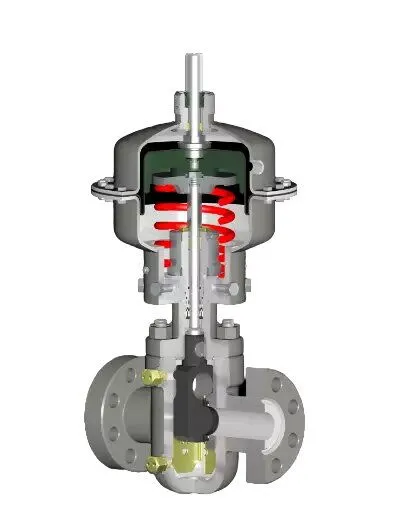Performance Analysis of Pneumatic Diaphragm Control Valves
On this page
Pneumatic diaphragm control valves play a crucial role in industrial process control, significantly impacting system stability and efficiency. This article provides a detailed analysis of the seven key performance indicators of pneumatic diaphragm control valves, including regulation function, shut-off function, differential pressure handling, anti-blocking capability, corrosion resistance, pressure resistance, and temperature resistance.
Regulation Function
The regulation function is the core performance of pneumatic diaphragm control valves, encompassing flow characteristics, adjustable range, small opening performance, flow coefficient, and regulation speed.
1. Flow Characteristics
Flow characteristics describe the relationship between the valve opening and flow rate, tailored to meet different system requirements. For example:
Flow Regulation Systems: Require fast-responding logarithmic characteristics to quickly react to flow changes.
Temperature Regulation Systems: Require slower-responding linear flow characteristics to ensure stable temperature control.
Excellent flow characteristics are a vital measure of a pneumatic diaphragm control valve's regulation quality.
2. Adjustable Range (R)
The adjustable range (R) indicates the range of flow that the valve can control, expressed as R = Qmax/Qmin. The larger the R value, the better the performance of the valve. For example:
Standard Control Valves: Typically have an R value of around 30.
High-Performance Valves: Such as V-type ball valves and multi-function ultra-light pneumatic diaphragm control valves, can have an R value of 100 to 200.
3. Small Opening Performance
Some valves perform poorly at small openings, leading to issues like stick-slip and oscillation, which reduce the adjustable range (i.e., increase Qmin). High-quality valves should have fine-tuning capabilities at small openings, allowing for precise control of very low flow rates while maintaining stability. Examples include: V-type Ball Valves, Eccentric Rotary Valves, Multi-function Ultra-light Pneumatic Diaphragm Control Valves.
4. Flow Coefficient (Cv or Kv)
The flow coefficient (Cv or Kv) represents the flow capacity of the valve. For the same diameter, a higher Cv or Kv value indicates better performance. For example:
Ball Valves and Butterfly Valves: Have Cv/Kv values 2 to 3 times greater than those of single-seat valves, double-seat valves, and sleeve valves.
5. Regulation Speed
Regulation speed reflects the valve's ability to respond to system actions, meeting the required speed of response for different applications. High-speed response systems demand valves with fast regulation speeds.
Shut-off Function
The shut-off function is indicated by the valve's leakage rate, typically requiring leakage to be less than 0.001%, which reflects the intrinsic quality of the valve. An excellent shut-off function ensures that the system can completely close when needed, preventing any medium leakage. This function is a critical measure of a valve's sealing capability.
Differential Pressure Handling Function
Differential pressure handling is usually expressed by the allowable pressure difference when the valve is closed. The greater the allowable differential pressure, the better the valve's performance. Inadequate consideration of differential pressure can result in the valve plug being forced open, preventing complete closure and leading to excessive leakage. Therefore, ensuring the shut-off function requires the valve to overcome the working differential pressure when closed.
Anti-blocking Function
When regulating dirty media or even clean media with impurities like welding slag, valves can become blocked or stuck. To ensure normal regulation, valves should possess strong anti-blocking capabilities. Valves with simple flow paths, such as: Single-Seat Angle Valves, Ball Valves, Butterfly Valves, Eccentric Valves, tend to have the best anti-blocking performance. In contrast, valves with complex flow paths, such as labyrinth-style multi-stage pressure reduction valves, are more prone to blockage.
Corrosion Resistance
Corrosion resistance refers to the valve's ability to withstand medium-induced corrosion, erosion, and cavitation, thereby extending its service life. Solutions to corrosion issues include:
Selecting Corrosion-Resistant Materials: Such as stainless steel or Hastelloy.
Erosion Resistance: Using wear-resistant materials like Stellite or tungsten carbide for high-velocity or particle-laden media.
Cavitation Prevention: Implementing anti-cavitation measures in valve design, especially for high-pressure and large differential pressure pneumatic diaphragm control valves, which often use multi-stage pressure reduction designs.
Pressure Resistance
Pressure resistance reflects the valve's strength and safety, ensuring that the medium does not leak through seals or valve body defects. Factory tests usually involve subjecting the valve to 1.5 times its nominal pressure to verify its pressure resistance. For high-pressure media, forged valve structures are preferred; cast iron valves have the lowest pressure resistance and are typically replaced by cast steel valves.
Temperature Resistance
Temperature resistance requires valves to maintain strength and performance under varying temperature conditions. Temperature changes can reduce the material strength of the valve body, so valves must withstand the full range of the medium's temperature variations to ensure good strength and safety at operating temperatures. For extreme high and low temperatures, valves should be made of materials and designs suitable for such conditions.
The performance of pneumatic diaphragm control valves directly affects the stability and efficiency of industrial process control systems. By thoroughly analyzing flow characteristics, adjustable range, small opening performance, flow coefficient, regulation speed, shut-off function, differential pressure handling, anti-blocking capability, corrosion resistance, pressure resistance, and temperature resistance, better selection and utilization of pneumatic diaphragm control valves can be achieved, enhancing the overall performance and reliability of the system.
